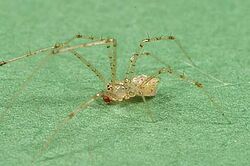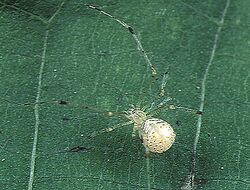Biology:Chrysso
| Golden comb-footed spider | |
|---|---|

| |
| male C. pulcherrima | |

| |
| female C. spiniventris | |
| Scientific classification | |
| Domain: | Eukaryota |
| Kingdom: | Animalia |
| Phylum: | Arthropoda |
| Subphylum: | Chelicerata |
| Class: | Arachnida |
| Order: | Araneae |
| Infraorder: | Araneomorphae |
| Family: | Theridiidae |
| Genus: | Chrysso O. Pickard-Cambridge, 1882[1] |
| Type species | |
| C. albomaculata O. Pickard-Cambridge, 1882
| |
| Species | |
|
64, see text | |
| Synonyms[1] | |
Chrysso is a genus of comb-footed spiders that was first described by Octavius Pickard-Cambridge in 1882.[3]
C. pulcherrima is pantropical, C. spiniventris has been introduced to Europe, and C. nordica occurs both in North America and in Asia from Hungary to Mongolia.
Description
Many species are strikingly colored, but like most theridiids, the coloration is variable. C. compressa has a striking black sternum and abdomen, but the venter of Brazilian species is black, while those of Peru are yellow. C. venusta has been observed to rapidly change its color when disturbed.
Females are about 9 millimetres (0.35 in) long, and have blade-like hairs on the tip of the abdomen.
Species
(As of May 2020) it contains sixty-four species, mostly found in the Americas and Asia:[1]
- C. albomaculata O. Pickard-Cambridge, 1882 (type) – USA, Caribbean to Brazil
- C. alecula Levi, 1962 – Panama
- C. anei Barrion & Litsinger, 1995 – Philippines
- C. angula (Tikader, 1970) – India
- C. antonio Levi, 1962 – Brazil
- C. arima Levi, 1962 – Trinidad
- C. arops Levi, 1962 – Brazil
- C. backstromi (Berland, 1924) – Chile (Juan Fernandez Is.)
- C. barrosmachadoi Caporiacco, 1955 – Venezuela
- C. bicuspidata Zhang & Zhang, 2012 – China
- C. bifurca Zhang & Zhang, 2012 – China
- C. bimaculata Yoshida, 1998 – China, Japan
- C. calima Buckup & Marques, 1992 – Brazil
- C. cambridgei (Petrunkevitch, 1911) – Mexico to Venezuela
- C. caudigera Yoshida, 1993 – China, Taiwan
- C. compressa (Keyserling, 1884) – Peru, Brazil
- C. cyclocera Zhu, 1998 – China
- C. dentaria Gao & Li, 2014 – China
- C. diplosticha Chamberlin & Ivie, 1936 – Panama to Peru
- C. ecuadorensis Levi, 1957 – Colombia to Bolivia
- C. fanjingshan Song, Zhang & Zhu, 2006 – China
- C. foliata (L. Koch, 1878) – Russia (Far East), China, Korea, Japan
- C. gounellei Levi, 1962 – Brazil
- C. hejunhuai Barrion, Barrion-Dupo & Heong, 2013 – China
- C. huae Tang, Yin & Peng, 2003 – China
- C. huanuco Levi, 1957 – Peru
- C. hyoshidai Barrion, Barrion-Dupo & Heong, 2013 – China
- C. indicifera Chamberlin & Ivie, 1936 – Panama to Peru
- C. intervales Gonzaga, Leiner & Santos, 2006 – Brazil
- C. isumbo Barrion & Litsinger, 1995 – Philippines
- C. lativentris Yoshida, 1993 – China, Korea, Taiwan
- C. lingchuanensis Zhu & Zhang, 1992 – China
- C. longshanensis Yin, 2012 – China
- C. mariae Levi, 1957 – Peru
- C. melba Levi, 1962 – Panama
- C. nigriceps Keyserling, 1884 – Colombia, Ecuador
- C. nigrosterna Keyserling, 1891 – Brazil
- C. nordica (Chamberlin & Ivie, 1947) – France , Hungary, Ukraine , Russia (Europe to Far East), Kazakhstan, Mongolia, North America
- C. orchis Yoshida, Tso & Severinghaus, 2000 – Taiwan
- C. oxycera Zhu & Song, 1993 – China
- C. pelyx (Levi, 1957) – USA
- C. pulchra (Keyserling, 1891) – Brazil
- C. questona Levi, 1962 – Costa Rica, Panama, Trinidad
- C. rubrovittata (Keyserling, 1884) – Brazil, Argentina
- C. sasakii Yoshida, 2001 – Japan
- C. scintillans (Thorell, 1895) – Myanmar, India, China, Korea, Japan, Philippines
- C. sicki Levi, 1957 – Brazil
- C. silva Levi, 1962 – Panama
- C. simoni Levi, 1962 – Venezuela
- C. subrapula Zhu, 1998 – China
- C. sulcata (Keyserling, 1884) – Peru, Bolivia, Brazil
- C. tiboli Barrion & Litsinger, 1995 – Philippines
- C. trimaculata Zhu, Zhang & Xu, 1991 – China, Taiwan, Thailand
- C. trispinula Zhu, 1998 – China
- C. urbasae (Tikader, 1970) – India
- C. vallensis Levi, 1957 – Panama
- C. vexabilis Keyserling, 1884 – Panama to Argentina
- C. viridiventris Yoshida, 1996 – Taiwan, Japan (Ryukyu Is.)
- C. vitra Zhu, 1998 – China
- C. vittatula (Roewer, 1942) – Colombia to Bolivia
- C. volcanensis Levi, 1962 – Costa Rica, Panama
- C. wangi Zhu, 1998 – China
- C. wenxianensis Zhu, 1998 – China
- C. yulingu Barrion, Barrion-Dupo & Heong, 2013 – China
Formerly included:
- C. acrobeles (Thorell, 1895) (Transferred to Coleosoma)
- C. albipes (Saito, 1935) (Transferred to Chikunia)
- C. argyrodiformis (Yaginuma, 1952) (Transferred to Meotipa)
- C. conigerum (Simon, 1914) (Transferred to Achaeridion)
- C. jianglensis Zhu & Song, 1993 (Transferred to Meotipa)
- C. maronica Caporiacco, 1954 (Transferred to Cryptachaea)
- C. octomaculata (Bösenberg & Strand, 1906) (Transferred to Coleosoma)
- C. pentagona Caporiacco, 1954 (Transferred to Achaearanea)
- C. picturata (Simon, 1895) (Transferred to Meotipa)
- C. rapula (Yaginuma, 1960) (Transferred to Chikunia)
- C. shimenensis Tang, Yin & Peng, 2003 (Transferred to Thwaitesia)
- C. sikkimensis (Tikader, 1970) (Transferred to Linyphia)
- C. vesiculosa (Simon, 1895) (Transferred to Meotipa)
See also
References
- ↑ 1.0 1.1 1.2 Gloor, Daniel; Nentwig, Wolfgang; Blick, Theo; Kropf, Christian (2020). Gen. Chrysso O. Pickard-Cambridge, 1882. Natural History Museum Bern. doi:10.24436/2. http://www.wsc.nmbe.ch/genus/3467. Retrieved 2020-06-12.
- ↑ 2.0 2.1 Levi, H. W.; Levi, L. R. (1962). "The genera of the spider family Theridiidae". Bulletin of the Museum of Comparative Zoology 127: 16.
- ↑ Pickard-Cambridge, O. (1882). "On new genera and species of Araneidea". Proceedings of the Zoological Society of London 50 (3): 423–442. doi:10.1111/j.1096-3642.1882.tb02749.x. https://www.biodiversitylibrary.org/partpdf/67444.
External links
| Wikimedia Commons has media related to Chrysso. |
- Guide to Common Singapore Spiders: Pictures of spiders and their webs
Wikidata ☰ Q2967436 entry
 |

